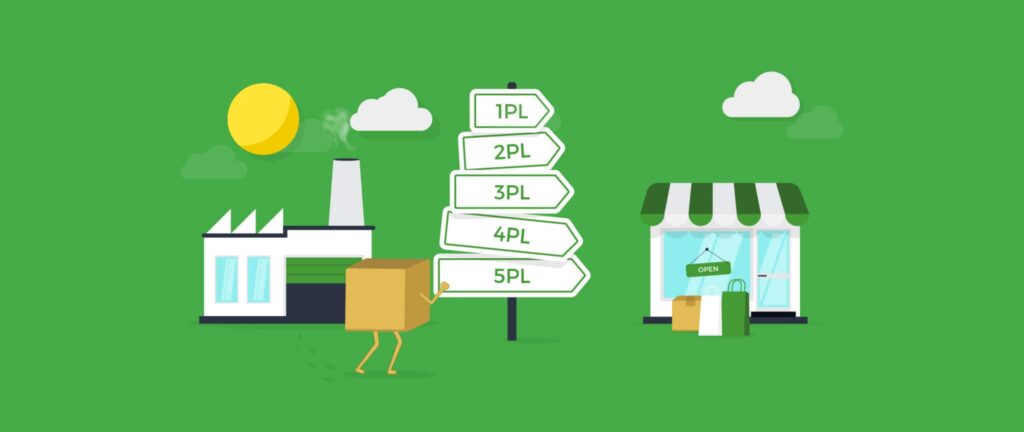Logistics. Here at ShipMonk, we live it and breathe it, but there’s no denying that this is one industry that, despite being ubiquitous in our daily lives, can leave “outsiders” feeling a bit puzzled. Of course, if you’re an ecommerce business owner, your paths are almost guaranteed to cross, even if you never actually step foot inside a fulfillment center.
Luckily, we have the scoop. Consider us an ice cream truck of logistical knowledge, ready to serve dollops of clarity regarding any doubts or questions you may have. Today, we’re tackling five basic models of logistics and what they can mean for your business — we’ll keep it fun, we promise!
Pro tip: Want to make your reading experience extra fun? Take a shot every time we say the word “logistics!” Play with caution. 😎
But First, What’s Logistics?
Think about the journey of an average online order. It travels far and wide just to reach your doorstep. But, what really happens along the way? How many checkpoints does a package pass before arriving to its final destination? As it turns out, there’s a whole lot going on between point A and point B, which is where logistics, or the coordination and management of complicated processes, comes in.
Logistics is a part of the overarching supply chain, and it can range from relatively straightforward to increasingly complex depending on the individual needs and capabilities of the parties involved.
From the ground up, here’s what each level of logistics looks like. Let’s begin!
1PL (First-Party Logistics)
Allow us to paint a scenario for you: Carl is a talented confectioner and founder of Carl’s Candy Emporium, home to all sorts of exquisite sugary goods, from taffy to gumballs and anything else you can possibly imagine. Carl makes all of his treats from scratch, which, in logistics terms, makes him the manufacturer.
Carl is eager to share his creations with the world, but he has to test the waters first. After much deliberation, he decides to send some of his most promising inventory to Kathy’s Sweet Shop, which is just a hop and a skip away from Carl’s candy laboratory. Dream big by starting small, right?
In this case, Kathy’s Sweet Shop is the market, or the recipient of the manufacturer’s goods. So far, this scenario only involves a manufacturer and a market, so it falls under first-party logistics.
But wait, there’s more!
2PL (Second-Party Logistics)
Things are heating up for Carl! Over at Kathy’s Sweet Shop, his candies are selling like hot cakes (some even are cakes!), so he decides to kick it up a notch by expanding his reach to other stores in nearby areas.
Of course, there’s no way that Carl can take on the responsibility of peddling his goods across county lines — he’s just one man, and he’s got candy to make. So, he hires a second-party logistics provider by the name of Teddy’s Trucks to lend him a helping set of wheels.
To sum it up, Teddy’s Trucks is now acting as Carl’s transporter, thereby introducing Carl’s Candy Emporium (still the manufacturer) to new and exciting markets. What can we say — Kathy’s Sweet Shop is just too small for a guy like Carl.
3PL (Third-Party Logistics)
Hello, global domination! Carl’s rendezvous with second-party logistics was a massive success, which brings us to the natural next step: turbo mode, a.k.a. establishing an online presence in addition to scaling brick-and-mortar operations.
But, after a few months on the World Wide Web, Carl finds himself elbow deep in cardboard boxes and tissue paper, rendering him unable to focus on the aspects of his business that originally sparked his passion. In order (pun intended) to keep up with the growing demand for his delicious products, Carl contacts a third-party logistics company that specializes in helping businesses reach their fullest potential — let’s call them MhipSonk.
At this stage, it’s important to note the following:
- With MhipSonk taking over the transporter role for Carl’s Candy Emporium, we bid farewell to Teddy’s Trucks, who will continue to do great work elsewhere.
- “But how?” you may be asking. “Does MhipSonk have trucks and planes of their own?” Well, not necessarily. What MhipSonk does have is a working relationship with various shipping carriers, which allows them to negotiate competitive rates and coordinate deliveries.
- To really sweeten (pun intended, again) the deal, MhipSonk’s services will actually extend beyond transportation, fulfilling other logistical functions like warehousing, packing orders, and managing inventory.
- Lastly, with Carl putting down digital roots, the end “market” now encompasses individual customers — people like you and me who shop online and are the final destination.
As you can see, 3PLs are decidedly more complicated than 2PLs and 1PLs — and, yes, it does get even more complicated after this. For the average ecommerce business owner, outsourcing to a 3PL is a permanent and reliable solution. But, if you’re feeling a little wild, we can keep going.
4PL (Fourth-Party Logistics)
With fourth-party logistics, a separate provider is added to manage and oversee a company’s entire supply chain. While a 3PL is more concerned with day-to-day tasks, the goal of a 4PL is to optimize the whole kit and caboodle — think coordinating suppliers and synchronizing workflows. Another major difference is that 4PLs offer a more “hands-off” approach to 3PLs, which usually require a fair amount of communication and coordination with merchants.
5PL (Fifth-Party Logistics)
As a newer logistics model, fifth-party logistics can encompass a variety of definitions. Essentially, 5PLs aggregate multiple 3PLs, moving from a supply chain to a supply network. If 4PLs act as consultants, 5PLs run the whole logistics show.
Whew! That was quite the ride — and we didn’t even get to 6PLs and 7PLs! But don’t worry, we’ve had enough acronyms for today.
P.S. Liked what you learned? Subscribe to our blog newsletter for our latest and greatest content, crafted with care and sent straight to your inbox!





